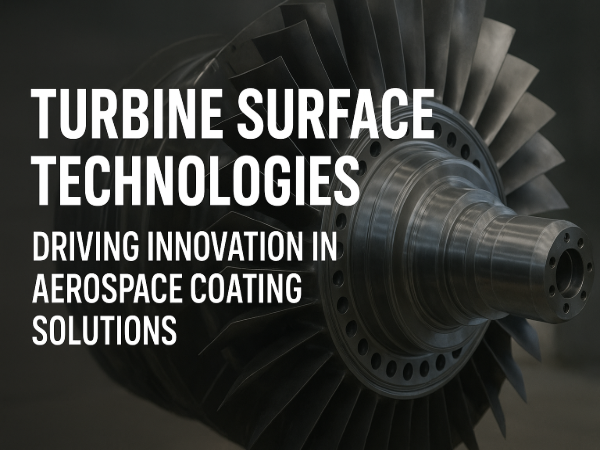Turbine Surface Technologies: Driving Innovation in Aerospace Coating Solutions
Pioneering Excellence in Gas Turbine Component Protection

Turbine Surface Technologies (TST) is a leading joint venture in the aerospace industry, specializing in advanced coating solutions for gas turbine components. By combining cutting-edge surface engineering technologies with a commitment to quality and innovation, TST plays a vital role in enhancing the efficiency, durability, and performance of modern turbines. With its expertise in processes such as aluminising, platinum plating, plasma spraying, and electron beam physical vapor deposition, Turbine Surface Technologies ensures that aircraft engines can operate safely and efficiently under extreme conditions.
Introduction: The Role of Coatings in Aerospace Engineering
Aerospace engineering is one of the most demanding fields in modern technology. Gas turbines, which power both commercial and defense aircraft, operate under extreme stress and high temperatures. Components inside these engines, particularly turbine blades and nozzle guide vanes, are constantly exposed to environments that can cause rapid degradation through oxidation, corrosion, and thermal fatigue.
To overcome these challenges, surface coatings are applied to protect critical components. These coatings serve as barriers, allowing turbine parts to operate at temperatures beyond the melting point of their base alloys. Without such protective layers, turbines would suffer premature failure, leading to reduced efficiency, costly repairs, and safety risks.
This is where Turbine Surface Technologies has established itself as an industry leader. By combining research, precision engineering, and state-of-the-art facilities, TST provides the aerospace sector with solutions that extend the lifespan of turbine components while improving fuel efficiency and engine performance.
The Origins of Turbine Surface Technologies
Founded in August 2000, Turbine Surface Technologies is the result of a strategic joint venture between Rolls-Royce, one of the most respected names in aerospace and defense, and Chromalloy, a global leader in advanced coatings and repairs for gas turbines. This collaboration brought together Rolls-Royce’s deep expertise in turbine design and Chromalloy’s proven experience in coating technologies.
The company was established with the goal of creating a center of excellence for turbine coatings, particularly for the hot section of gas turbine engines. Its facility in Nottinghamshire, UK, was purpose-built to deliver world-class coating services for Rolls-Royce engines and, by extension, for the global aerospace market.
Why Coatings Matter in Gas Turbines
Thermal Protection
Gas turbines operate at temperatures exceeding 1,500°C, far higher than the limits of most superalloys. Thermal barrier coatings (TBCs) allow these parts to withstand such heat by providing insulation.
Oxidation and Corrosion Resistance
Coatings protect turbine blades and vanes from oxidation, sulphidation, and other forms of chemical attack. This extends component lifespan and ensures reliability.
Fuel Efficiency
By enabling engines to run hotter, coatings improve combustion efficiency. This results in better fuel consumption rates, lower emissions, and improved overall performance.
Cost Savings
Extending the life of turbine components reduces maintenance costs and minimizes downtime. For airlines and defense operators, this translates to significant savings over an aircraft’s service life.
Core Technologies at Turbine Surface Technologies
Turbine Surface Technologies has developed and mastered a range of specialist processes. Each technique is tailored to address specific challenges faced by turbine components.
Aluminising
Aluminising introduces aluminum into the surface of components to form protective aluminide coatings. These coatings provide excellent resistance to oxidation and corrosion.
Platinum Plating
Using electroplating techniques, a thin layer of platinum is deposited onto components. Often combined with aluminising, platinum plating enhances both corrosion resistance and thermal stability.
Electron Beam Physical Vapor Deposition (EB-PVD)
This advanced process applies ceramic coatings with a columnar microstructure. EB-PVD coatings provide exceptional thermal stress resistance, making them ideal for turbine blades.
Atmospheric Plasma Spray (APS)
APS coatings are robotically applied using high-energy plasma. This process creates porous ceramic coatings that act as thermal barriers, protecting underlying alloys from extreme heat.
Low Vacuum Plasma Spray (LVPS)
LVPS is used for applying dense, high-quality bond coatings such as MCrAlY (nickel, cobalt, chromium, aluminum, yttrium). These bond coats serve as the foundation for ceramic top layers, ensuring durability and adhesion.
Quality and Certifications
To maintain its position as a trusted supplier, Turbine Surface Technologies adheres to the highest industry standards. The company holds certifications such as:
NADCAP (National Aerospace and Defense Contractors Accreditation Program)
AS9100 (Aerospace Quality Management System)
ISO 14001 (Environmental Management)
ISO 45001 (Occupational Health and Safety)
These certifications reflect TST’s commitment to safety, environmental responsibility, and continuous improvement.
The Human Side: Culture and Values
While technology is central to Turbine Surface Technologies, its success is equally built on people. The company emphasizes a culture of openness, collaboration, and integrity. Employees are encouraged to uphold safety, quality, and ethical standards in every process.
By fostering a “right first time” mindset, TST ensures that quality is embedded in every stage of production. This culture not only strengthens customer confidence but also drives innovation and efficiency across the organization.
Applications in Aerospace
The coatings developed by Turbine Surface Technologies are primarily applied to high-pressure (HP) turbine blades, intermediate-pressure (IP) blades, and nozzle guide vanes (NGVs). These components are critical for maintaining engine thrust, efficiency, and reliability.
Through its work, TST contributes to the success of Rolls-Royce engines that power a wide range of aircraft—from commercial airliners to advanced military jets.
Research and Innovation
Innovation is at the core of TST’s operations. The company invests heavily in research and development to push the boundaries of coating technology. Current areas of focus include:
Next-generation ceramic materials with improved resistance to calcium-magnesium-alumina-silicate (CMAS) infiltration.
Multi-layer thermal barrier coatings that provide superior insulation and durability.
Advanced bond coats designed to enhance coating adhesion and oxidation resistance.
Environmentally friendly processes that reduce waste and energy consumption.
These efforts ensure that Turbine Surface Technologies remains at the forefront of the aerospace industry, ready to meet the challenges of future engine designs.
Global Impact and Future Outlook
The aerospace industry continues to evolve rapidly, with increasing emphasis on fuel efficiency, reduced emissions, and sustainable practices. Gas turbine engines are central to this transformation, and surface technologies play a critical role in enabling new performance benchmarks.
As aircraft manufacturers and operators demand higher efficiency, Turbine Surface Technologies is well-positioned to deliver. Its focus on innovation, combined with its strong heritage through Rolls-Royce and Chromalloy, ensures that it will remain a key player in the global aerospace supply chain for decades to come.
Looking ahead, TST is expected to expand its capabilities into emerging markets such as renewable energy turbines and advanced propulsion systems. The same coating expertise that supports aerospace applications can also contribute to cleaner, more efficient power generation.
Conclusion
Turbine Surface Technologies is more than just a coating provider—it is a pioneer in aerospace innovation. Through its advanced processes, rigorous quality standards, and culture of continuous improvement, TST ensures that gas turbines operate safely, efficiently, and reliably under extreme conditions.
In a world where efficiency and durability are critical, Turbine Surface Technologies stands as a cornerstone of progress in aerospace engineering. By enabling engines to run hotter, last longer, and perform better, TST continues to drive the industry forward, shaping the future of aviation and beyond.



